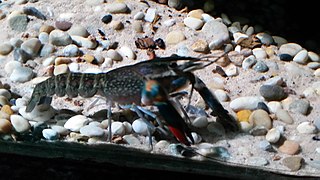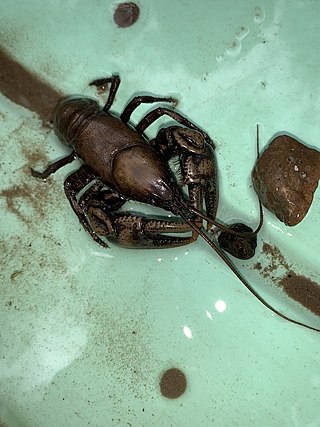The blue crayfish is Procambarus alleni, of which an electric blue morph is common in aquaria.
Blue crayfish may also refer to:
Also, three North American burrowing crayfish have 'blue' in their common name:

Crayfish are freshwater crustaceans belonging to the clade Astacidea, which also contains lobsters. In some locations, they are also known as crawfish, crabfish, crayboiz, crawdaddies, crawdads, freshwater lobsters, mountain lobsters, rock lobsters, mudbugs, baybugs or yabbies. Taxonomically, they are members of the superfamilies Astacoidea and Parastacoidea. They breathe through feather-like gills. Some species are found in brooks and streams, where fresh water is running, while others thrive in swamps, ditches, and paddy fields. Most crayfish cannot tolerate polluted water, although some species, such as Procambarus clarkii, are hardier. Crayfish feed on animals and plants, either living or decomposing, and detritus.

Cambarus is a large and diverse genus of crayfish from the United States and Canada. The adults range in size from about 5 cm (2.0 in) up to approximately 15 cm (5.9 in).
Blue lobster may refer to either:

The Everglades crayfish, sometimes called the Florida crayfish, the blue crayfish, the electric blue crayfish, or the sapphire crayfish, is a species of freshwater crayfish endemic to Florida in the United States. Its natural range is the area east of St. Johns River and all of Florida from Levy County and Marion County southwards, as well as on some of the Florida Keys. It is included on the IUCN Red List as a species of Least Concern. The blue crayfish is frequently kept in freshwater aquaria. In the wild, this species varies from brown-tan to blue, but an aquarium strain has been selectively bred to achieve a brilliant cobalt blue color.
Cambarus catagius, the Greensboro burrowing crayfish, is a species of crayfish in the family Cambaridae. It is found only in a limited area of North Carolina, where it is considered a species of special conservation concern.
Cambarus cymatilis, the Conasauga blue burrower is a species of burrowing crayfish in the family Cambaridae. It is native to Tennessee and Georgia in the United States.. The common name refers to the Conasauga River.
Cambarus harti, the Piedmont blue burrower, is a species of burrowing crayfish in the family Cambaridae. It is endemic to Georgia in the United States.. The common name refers to the Piedmont plateau region.
Cambarus truncatus, the Oconee burrowing crayfish, is a species of crayfish in the family Cambaridae. It is found in North America.

The Big Sandy crayfish, Cambarus callainus, are freshwater, tertiary burrowing crustaceans of the family Cambaridae. They are found in the streams and rivers of Appalachia in Virginia, West Virginia, and Kentucky, in what is known as the Big Sandy watershed. Populations are often mistaken with Cambarus veteranus, but morphological and genetic data suggests that these are separate taxa; however, both are protected under the Endangered Species Act. There is very little information available on the Big Sandy crayfish because it is a relatively new species.
The name common crayfish may refer to different species in different places:

Faxonius immunis is a species of crayfish in the family Cambaridae. It is native to North America and it is an introduced species in Europe, where it lives along the Upper Rhine. Its common names include calico crayfish and papershell crayfish.

Cambarus carinirostris, the rock crayfish, is a species of crayfish in the family Cambaridae. It is found in the mid-Atlantic region of the United States.

Cambarus monongalensis, the blue crayfish or Monongahela crayfish, is a species of burrowing crayfish native to Pennsylvania and West Virginia. It has also been found recently in Ohio. The common name refers to the Monongahela River, with the first specimens being collected from Edgewood Park, Allegheny County, Pennsylvania. It is included on the IUCN Red List as a species of Least Concern.